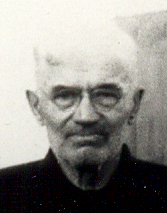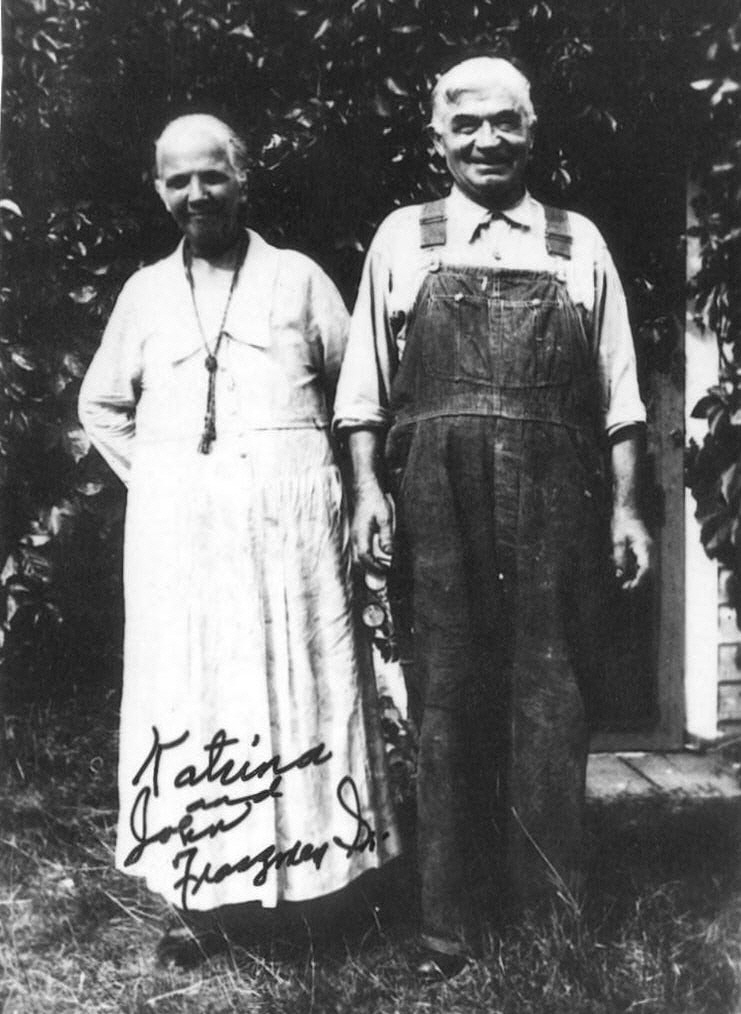Franzman Ancestors
Georg Philipp Franzmann Jr.: b. 1 Nov 1829, d. 07 Mar 1875
Christina Krater: b. 20 Mar 1828, d. 18 Jan 1880
Georg Franzmann Jr. and Christina Krater
Georg Franzmann was born on November 1, 1829 to Georg Philip Franzmann Sr. and Regina Barbara Gross. Georg was Johann Franzmans father (John Franzman's grandfather. Georg married Christina Krater on February 6, 1853. They lived in Dobrostany, Galicia where Georg was born. At that time in history Dobrostany was part of Austria, but the borders have been redrawn since then and today, Dobrostany is located in Ukraine. Christina was born in Reichenbach, Galicia very close to where the Franzmans lived. All of theses Galician cities - Dobrostany, Reichenback, Dornfeld, Lemberg - are now renamed and located in Ukraine near the city of Lviv.
At age 45, Georg became lost travelling through a forest and froze to death. Christina then married Wilhelm Jakob Stengel on August 18 1878 in Dornfeld, Styria, Austria. She died two years later at age 51.
About Galicia: In the late 1700s, Galicia fell under the rule of the Habsburgs and was part of the Austrian Empire. Many Germans immigrated to Galicia in the late 1700s as foreign settlers and Protestants were allowed and encouraged to establish communities there. Our German/Austrian ancestors were part of this migragtion during the time that Austria ruled Galicia. At the end of World War I, Galicia was annexed by Poland. Eventually, and after much conflict between the Poles and the Ukraines, Galicia ceased to exist and Poland retained the western lands while Ukraine gained the east.
Georg and Christina had five children:
- Philipp (1852-1898)
- Georg (1855-1896)
- Margaretha (1860-1861)
- Karl (1862-1863)
- Johann (1866-1938) - father of John Franzman Jr.
References
Philipp Franzmann
b. 1 Jan 1853, d. 1898
Philipp Franzmann was born on January 1st, 1853, in Dornfield. He married Elizabetha Heiler on August 13, 1876, also in Dornfield. They had seven children:
- Sophia Franzmann (1873-1955)
- Georg Franzmann (1875-1936)
- Margaretha Franzmann (1877- )
- Phillipp Franzmann (1879-1884)
- Elisabeth Franzmann (1882-1912)
- Phillipp Franzmann (1884-1887)
- Katharina Franzmann (1887-)
Phillipp died in 1898 in Krasow, Galicia (Krasiv, Ukraine). Cause of death: im Brunnen verschüttet (buried in the well!?)
References
Georg Franzmann
b. 24 Mar 1855, d. 9 Jan 1896
Georg Franzmann was born on March 24th, 1855 in Dobrzany, Galicia (Szczerzec, Ukraine. He married Maria Elizabetha Adam on 1880, also in Dobrzany. They had seven children:
- Karl Franzmann (1881-)
- Georg Franzmann (1883-1883)
- Johann Franzmann (1884-1886)
- Johann Franzmann (1887-)
- Katharina Franzmann (1889-1891)
- Katharina Franzmann (1892-1896)
- Christina Franzmann (1894-1896)
- Georg Franzmann (1896-)
Georg died on Jan 9th, 1896 in Dobrzany Galicia (Szczerzec, Ukraine.)
References
Margaretha Franzmann
b. 02 Feb 1860, d. 29 Jan 1896
Margarethe Franzmann was born on Feb 2nd, 1860, in Dobrzany, Galicia (Szczerzec, Ukraine). She died on Jan 29th, 1861, in Dobrzany, just before her 1st birthday.
References
Karl Franzmann
b. 22 July 1862, d. 04 Sep 1863
Karl Franzmann was born on July 22nd, 1862 in Dobrzany, Galicia (Szczerzec, Ukraine). He died on September 4th, 1863, in Dobrzany shortly after his first birthday.
References
Johann Franzmann
b. 05 Jan 1866, d. 06 July 1938


Johann was the youngest child of Georg and Christina Franzmann. He was nine years old when his father Georg died. Johann gained a stepfather when Christina married Wilhelm Stengel in 1878. Christina died in 1880 when Johann was 14. Ancestry records indicated that his two oldest brothers Philipp (age 37) and Georg (age 35) were living at this time, as was his stepfather. However according to the family's oral history, Johann was considered an orphan and was housed and schooled by the government after his mother's death.
Johann was a good student and learned a number of languages. He excelled at drawing and woodworking and learned about wood finishing, carving, and cabinet-making. While serving in the Austrian army, he spent much of his time making furniture for his superior officers. He created dining room sets, bedroom funiture, and fancy tables for the officer's homes.
Johann met his soon-to-be wife at church in Galica. Ida Franzman Lutz, Johann's daughter, recounts the following story in her Biography of John Franzman:
"Father was concerned about finding a good wife, so one Sunday while attending church, a very beautiful young woman came in and sat down next to an old crippled woman. Being impressed by this he decided that he must meet this young woman and soon came the opportunity. Her name was Katharine Schick, and since John was such a handsome and charming young soldier, mother said, she was happy and pleased to date him. They were soon engaged and later were married." They married in 1892.
On April 1st, 1892, Johann left for America to look for opportunity and a place to live. He boarded a ship in Hambug, Germany and sailed to Canada, making his way to Winnipeg. By August he had enough money for Katharine's passage and she joined him in Winnipeg. Their first child Gustaf was born there, but died in infancy.

Finding work as a furniture maker was very difficult. Beds were now being made of metal and people couldn't afford fancy furniture, so he looked for work on the farms. He had never done farm work, and language was
also an obstacle. He often told this story, taken from Ida's written biography:
He was told by his friends never to say no he couldn't do a certain job, but always be willing to try anything. A farm widow asked for a gardener, so he immediately posed as such. He was to set out a quarter acre of onions. He didn't know how to do this but didn't dare ask, so he went to work and set out all the onions. When the land lady appeared she was shocked. "You have the roots up!" she screamed. He then shamefacedly explained the situation and reset all the onions.
Johann and Katharine eventually moved to Crystal, North Dakota where they lived and farmed among other German settlers. They gradually learned the English language and Johann learned how to farm. Katharine was an expert cook and pastry maker, and she helped in the farm kitchen. They had two children during this time, Alfred born June 11 1894, and Wilhelmina Francis (Minnie) born January 18 1896.
About this time a new territory in Northern Minnesota was opened up and advertised free 160-acre plots for settlers willing to move and stay on the land for five years. After five years, the settlers would obtain homestead rights to the property. In the fall of 1897, Johann and Katharine and their young family moved east to claim land of their own in Minnesota. They found a wooded 160-acre lot near Grygla, MN and decided to call this home. They lived in a shack that first winter, during which daughter Ida was born - a late Christmas baby born on Dec 26, 1897.
According to Ida:
The following spring they cleared a piece of ground, felled trees, and built a log-house with a sod roof. Three dollars was the entire cost of this house in which they lived for three years. There was a wide shelf on one wall, when the heavy rain-storms came the roof leaked, mother set her three little children under the shelf and
put felt hats on their heads. This way the rain dripped off and they didn't get wet.
Johann never lost his interest in cabinet making and woodworking. In 1930, he offered to build an altar for the first German Church being built in Grygla. He worked in a shed at the back of his property, hand-carving pieces to assemble into the altar. He used a lathe, the only modern piece of equipiment in the shed, to turn railings and other decorative pieces. Eventually Johann built four altars and associated kneeling rings, pulpits, and baptismal founts. Each set was a different design, but all contained Johann's intricate wood mosaic work.
In Ida's words:
This delicate work took much time and patience. Father always drew his designs. Special kinds of seasoned hardwood and veneer had to be sent for. The wood was carved with special kinds of tools by hand and then polished. He used a jig-saw to cut the smaller pieces which had to be glued and pressed. Some was inlaid work. Finally it was decorated in gold.
All four altars exist today. See Johann Franzmann's Altars
In all Johann and Katherine had 6 children:
- Gustav (abt 1893-1893)
- Alfred (1894-1959)
- Wilhelmina (Minnie) (1896-1992)
- Ida (1897-1998)
- John Jr. (1902-1972)
- Alice (1907-1999)
References
Slightly Deeper Roots
The Franzmann roots go back to the municipality of Boos in the Rheinland-Pfalz area of Germany. (About 60 miles southwest of Frankfurt). Johann's great-grandfather Johann Nikolaus was born in Boos. The Franzmanns likely immigrated to Galicia to take advantage of benefits offered by the Austrian Empire to settle there and establish a German/Austrian presence in the east. The Rheinland-Pfalz area of Germany had also been subject to on-and-off-again wars with the French, of which many Germans had had enough.
Johann's great-grandmother Margarethe Catwinckel was born in Weisbaden about 25 miles (40 km) from where Johann Nicolas lived. She and Johann Nikolas married after they were in Galicia.
The early Franzmanns and Schicks lived about 13 miles (22 km) apart from each other in Germany. Wonder if they could have known each other?
Johann Nikolaus and his widowed mother moved to the Dornfeld area (now Ternopillja, Ukraine) located about 20 miles (32 km) south of Lviv. Records from the Genealogy Research Center of the Galicia Germans indicated that by 1788, Johann Nikolaus and Margarethe Catwinckle, now married were farming in Dornfeld. The records also list Johann as a Schmied (blacksmith) and associated with grooming tools.
Johann Nikolaus and Margarethe raised their family in Neu Chrusno, located a very short distance from Dornfeld. "Our" Johann, who eventually moved to the United States, was born in Dobrzany and baptised in Dornfeld. His parents and siblings are buried in Dornfeld.